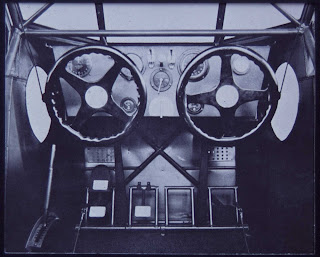Hopes Fade
Eventhough no definite destination had been stated by Captain Hinchliffe to his agents it was thought by fellow aviators that the plane would be Mitchell Field at Long Island. Thousands gathered there keeping a vigil in the hope that they would welcome the brave fliers to the US. Captain Bender, the operations officer, stated that he would keep the going there, and at nearby Curtis Field, if it was believed that the Endeavour was still in the air. But as the newspapers for the morning of the 15th went to bed experts knew that hope of a successful 'hop' were fading.
The Detroiter, a plane 32 feet long with a 45ft 10in wingspan had a cruising speed of 105 miles in normal conditions and weight, and could fly as high as 14,000 feet using 11 1/2 gallons of fuel an hour. Calculations showed that even with a reduced cruising speed of 90 mph due to the fuel being carried and adverse weather conditions the Endeavour was still now past the time it could have been reasonably expected. Ship passengers and crews arriving at New York began to report storms in mid ocean. The captain of the Majestic, a ship that Elsie had travelled on frequently with her father, said that there had been strong westerly gales.
Friends of Captain Hinchliffe's refused to give up hope and, like Emilie Hinchliffe, they had complete faith in his ability to succeed. He was known amongst them as a "storm wizard" who flew largely by natural instinct. It was said in British aviation circles that "he could just about fly to Paris, Amsterdam or Cologne with his good eye shut if necessary."
A message from St John's, Newfoundland was quoted in The Glasgow Herald: "Is is sunset and still there is no news of Captain Hinchliffe. If he approaches this coast tonight he will find great difficulty in locating the Harbour Grace Airfield because the plance is unlighted and he will perhaps be forced to descend in the suburbs of St John's, the only area which he is likely to be able to identify. Seafaring opinion here is very dubious on the subject."
False sightings are reports started to cause further complications for those anxious to hear news of the flight. Only an hour after the crowds at Mitchell Field had started to disperse believing hope was lost a radio station broadcast the news that the plane was due at New York and almost seven thousand people returned to greet the flyers. At midnight searchlights, including one that shone thirty miles into the sky, and beacons were turned on again to add to the great buzz of expectation. Troops were drafted in to help the police control the huge crowed but eventually as the hours ticked by, the lights were switched off and the people once again drifted away.
#aviation #aviationhistory #flight #womenshistory
 |
| Cockpit of the Stinson Detroiter - featuring duel controls |
The Detroiter, a plane 32 feet long with a 45ft 10in wingspan had a cruising speed of 105 miles in normal conditions and weight, and could fly as high as 14,000 feet using 11 1/2 gallons of fuel an hour. Calculations showed that even with a reduced cruising speed of 90 mph due to the fuel being carried and adverse weather conditions the Endeavour was still now past the time it could have been reasonably expected. Ship passengers and crews arriving at New York began to report storms in mid ocean. The captain of the Majestic, a ship that Elsie had travelled on frequently with her father, said that there had been strong westerly gales.
Friends of Captain Hinchliffe's refused to give up hope and, like Emilie Hinchliffe, they had complete faith in his ability to succeed. He was known amongst them as a "storm wizard" who flew largely by natural instinct. It was said in British aviation circles that "he could just about fly to Paris, Amsterdam or Cologne with his good eye shut if necessary."
A message from St John's, Newfoundland was quoted in The Glasgow Herald: "Is is sunset and still there is no news of Captain Hinchliffe. If he approaches this coast tonight he will find great difficulty in locating the Harbour Grace Airfield because the plance is unlighted and he will perhaps be forced to descend in the suburbs of St John's, the only area which he is likely to be able to identify. Seafaring opinion here is very dubious on the subject."
False sightings are reports started to cause further complications for those anxious to hear news of the flight. Only an hour after the crowds at Mitchell Field had started to disperse believing hope was lost a radio station broadcast the news that the plane was due at New York and almost seven thousand people returned to greet the flyers. At midnight searchlights, including one that shone thirty miles into the sky, and beacons were turned on again to add to the great buzz of expectation. Troops were drafted in to help the police control the huge crowed but eventually as the hours ticked by, the lights were switched off and the people once again drifted away.
#aviation #aviationhistory #flight #womenshistory


Comments
Post a Comment